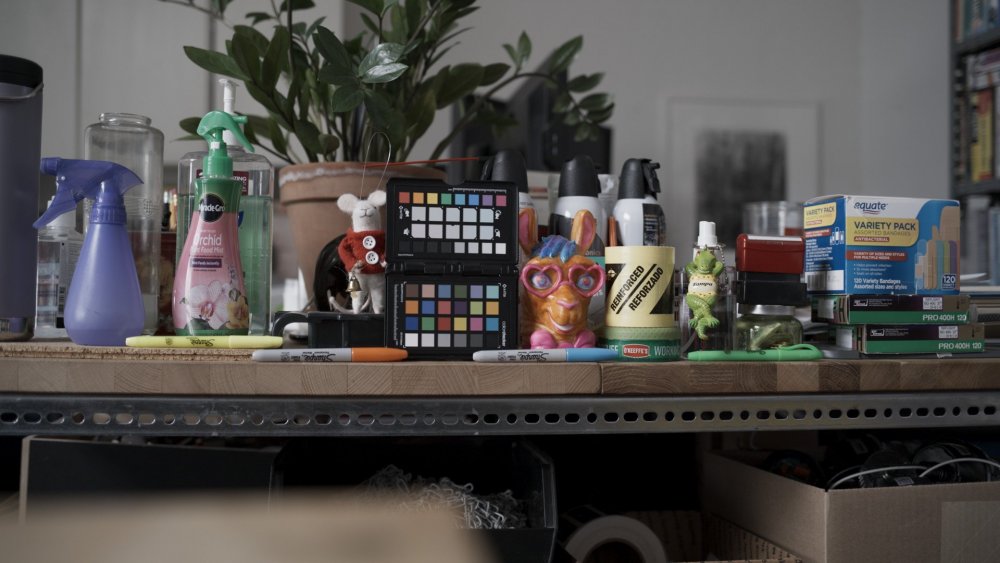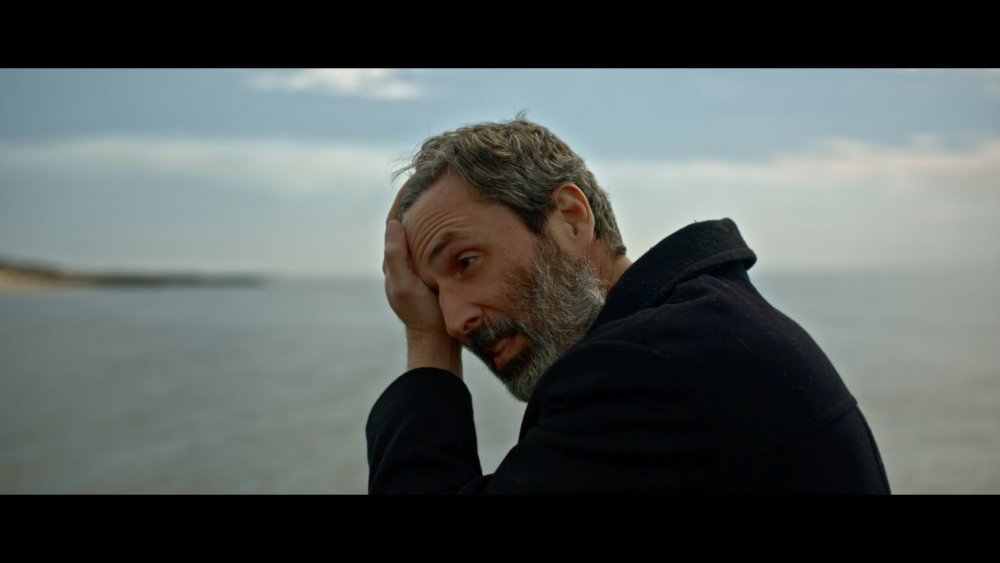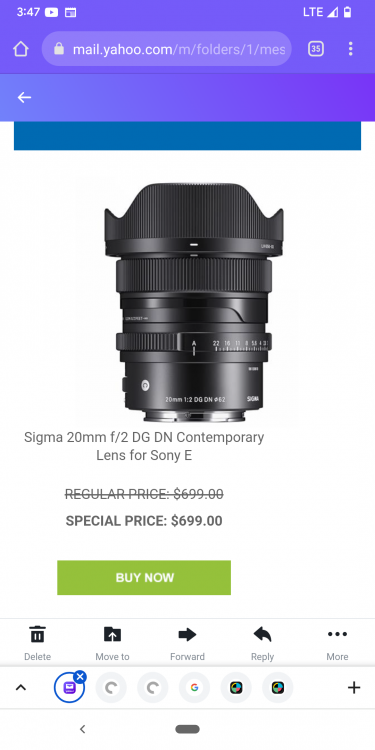Leaderboard
Popular Content
Showing content with the highest reputation on 05/07/2022 in all areas
-
GH6 and S5 " Comme vous pouvez le voir dans la vidéo, le S5 et le GH6 se marient à la perfection ! La nouvelle color science du GH6 est presque quasi-identique à celle du S5. D'ailleurs, je vous met au défi de me trouver les plans filmés en micro 4/3 et les autres filmés en 24x36. Nous avons aussi été bluffé par la stabilisation du boitier assez incroyable. Tous les plans du GH6 ont été tournés en run & gun ! " Google Translate " As you can see in the video, the S5 and the GH6 go together perfectly! The new color science of the GH6 is almost identical to that of the S5. Besides, I challenge you to find me the shots filmed in micro 4/3 and the others filmed in 24x36. We were also amazed by the quite incredible stabilization of the case. All the plans for the GH6 were shot in run & gun! " Google Translate2 points
-

SIGMA FP with ProRes RAW and BRAW !
mercer and one other reacted to webrunner5 for a topic
Put a Coke Cola can in that scene. Everyone knows what Red looks like with it as a reference. You have to have the 3 primary colors represented.2 points -
I got the FP working with the Ursa viewfinder. I used a BMD microconverter and a 4-pin XLR to barrel cable, and then a barrel to usb-c 12V Power Delivery cable, connected to a powerbank with a 12V PD output. The microconverter can't be connected to the same powerbank, I don't know why. Some loop I guess. So it needs it's own powerbank. I'm still waiting on an FP cage, but testbench-style it all works. It won't be light, but the picture in the EVF is stunning. I swear the lag is better than I remember it to be on the UMP4.6K Gen 1. As in, basically no lag. That bit surprised me.2 points
-
SIGMA FP with ProRes RAW and BRAW !
webrunner5 reacted to Llaasseerr for a topic
1 point -
Pretty sure that the Lift/Gamma/Gain controls are designed for use on 709 footage, and the Contrast/Pivot/Offset are designed for use on Log footage. This might (I'm guessing here) have implications for how the out-of-bounds values are handled (eg, the curves might do predictable things and the LGG might not). To make a more general comment in the context of the bewildering complexity of the various colour spaces and gammas that are being discussed in this thread, Resolve is now getting to be a very sophisticated engine when it is put into a "colour managed" mode (RCM or ACES) and in the most recent versions some of the controls are now "Colour Space Aware" so will act differently depending on what colour space you have told Resolve that the project is in. To expand on this somewhat, you might have footage that's shot in one LOG format, and if you tell Resolve to manage the colour space in the same log format that matches the footage, and you adjust the Offset wheel +1 then you will get the same results as if you shot the footage exposing one stop brighter. However, if you do the same but don't match the log format of the project to the footage the same +1 adjustment will do strange things because Resolve is doing complex things underneath the surface to tailor its behaviour to the specific colour space you've told it to work in. I've confirmed this to be the case with the HLG files from my GH5, which (almost!) line up perfectly with rec2100. In previous versions of Resolve without colour management (I never tried ACES) I shot two clips one stop different and tried to duplicate one shot by modifying the other shot, but I failed to find a combination of colour space and tool that would do the correction. Now in Resolve 17 in Resolve Colour Managed mode it's dead easy to do it and the +1 control on the Offset wheel does an almost perfect job. (On footage that is directly aligned to a colour space in Resolve, the transformation is perfect - HLG on the GH5 isn't). I suspect that this means that some tools effectively have a CST prior to their adjustment and then one after it to put the footage back into the mode that your project is in. This isn't the only place that Resolve does "hidden" CSTs in - you can program individual nodes to do that too I think. I had a long and rather frustrating conversation with a pro colourist when I asked about configuring projects to use RCM and they essentially advised me to do everything manually, despite using the RCM modes (of CSTs) being the proper way to do things. I think the advice was well intended and was simply coming from a place of concern for the depth of complexity actually involved in the tool, and their (probably frequent) experience of non-post-pros going down the rabbit hole and essentially getting lost, so putting up a fence to protect people from the journey makes sense considering how many of them never make it to the other side. (I was also trying to do something a bit horrible that complicated the workflow beyond how that mode is designed to be used, so my example was even worse than the standard situation). To make an even broader comment about this whole thread I am reminded of a long conversation / debate about if there was any magic in the Alexa ARRIRAW files, and it was pretty clearly showed from some under/over tests that the RAW from the Alexa was a completely neutral linear capture - just like how sensors are designed. This should be true of the RAW output from any sensor because it's literally how sensors work. The challenge is how to process it in a way that gives you the results you want. It's true there are potentially slight differences between the frequency response of various R G B filters on the sensor, but they're likely to be relatively similar and can easily be adjusted with an RGB matrix if you're really keen on matching cameras (that's the basis of the BM RAW conversions from Juan Melara IIRC). Otherwise, you can simply take the RAW Linear files from any RAW camera and apply whatever conversions you like - if you like the ARRI colour science then apply their LUTs or transforms, etc. It's also worth stating that many heavy colour grades will completely obliterate any sense of colour accuracy so I would imagine the pursuit of it is really only relevant in situations where a natural or hyper-natural (eg, commercial look where everything has to be cleaner than real life) look is required.1 point
-

SIGMA FP with ProRes RAW and BRAW !
Llaasseerr reacted to hyalinejim for a topic
I haven't been following this topic very closely and don't have an FP so disregard this if it's not relevant or has been covered already. I can tell you from much experience of looking at colour charts that the colours in "OFF" are far more accurate and true to life than in "ON". The blue patch is a giveaway here as it often is when a colour gamut or matrix is being interpreted incorrectly: in the "ON" version that patch is too purple.1 point -

The Thread for Good Deals and Discounts
HockeyFan12 reacted to homestar_kevin for a topic
Someone shared this on dpreview m43's forum, I couldn't resist. I have m43 to Sony E and Nikon Z adapters, so plan on using these adapted to FF. Adorama back at it again with some Samyang/Rokinon price craziness, this time in the m43 mount I thought $230 was low for the 24mm 1.5 last year, now it's at $150! They have most focal lengths and some kits available. The 135mm 2.2 is $140, the 50mm is $130 The 24mm, 35mm, 85mm kit is $350! https://www.adorama.com/l/Video/Video-Lenses-and-Accessories/Samyang~Digital-Cinema-Lenses?sel=Lens-Mount_Micro-Four-Thirds1 point -
Panasonic S5 User Experience
Mark Romero 2 reacted to stephen for a topic
Sigma 24-70mm f2.8 DG DN has almost 0 breathing and manual focus is smooth for a focus by wire lens. With latest firmware that gives extra control over focusing similar to Panasonic lenses it is almost perfect for video. Was pleasantly surprised. But it is relatively big and heavy 🙂1 point -

SIGMA FP with ProRes RAW and BRAW !
kye reacted to hyalinejim for a topic
One valid reason not to ETTR on every shot is that it creates extra work in balancing exposure in post, versus exposing for middle grey where the same correction should work for each clip regardless of highlight level.1 point -
It's definitely tilted towards the needs of the professional user over the casual enthusiast I would say. Features like DR Boost, ProRes internal, and compulsory 4-channel audio (you can't take a stereo track into post as far as I can see), potentially make life better for the dedicated pro, but probably more fiddly for the enthusiastic amateur. Full V-log curve seems to be a bit of a gimmick as you're not able to stretch the DR past what V Log L would have allowed from what I can calculate (admittedly not my area of expertise). V Log highlight clipping occurs around 88 IRE (compared to 82 for V Log L, and 109 for full V Log range). That said, as previously mentioned, DR Boost is definitely worthwhile, and gives the crucial little bit of DR I've been crying out for with this series. It doesn't turn the camera into a dreamy DR monster, but it does take the edge off of that burnt-out DSLR look, and seems to help both highlights and shadows. I don't want to oversell it, because it really just adds a touch of latitude rather than a major transformation, but its a very useful addition in my book. What is also fantastic is full V-Log gamut, which seems to be providing much richer, more natural and accurate colours. I'm really enjoying shooting with it. I think that if you're not going to be using V Log you've got some problems though. DR looks much reduced, and from looking at online tests it looks like it may be even worse than the GH5! That's not good news really. Is there any point in using Linear DR+ mode when V Log (with DR+ Off) offers greater dynamic range? I'm really pleased with my camera so far. It's familiar enough that I'm getting some muscle-memory imbedded straight away, but progressive enough that its challenging me in some interesting new ways. As well as the obvious headline features, one thing that really strikes me is that Panasonic have really sat down and thought about how to make this camera better from top to bottom. Some innovations I really like are: Improved Custom Modes. You can now save 13 Custom Modes (and crucially give them names that come up on the screen when you turn the dial). That's up from 5 (un-nameable) on the GH5 if memory serves correctly. Same topic, but you can now choose how the custom modes respond to shutdown/sleep, etc., even to the point of excluding certain values. This is massive because the previous CM system was practically unusable due to the way it kept resetting exposure values 😖. There's a lock switch, and again, you can dial in exactly what you want it to lock and not to lock. I'm using it just to protect my shutter angle dial. Hallelujah! You can use 4-channel recording in conjunction with the (separate accessory) XLR input and the minijack socket. You can now (I think) use this setup to patch a safety channel from the XLR, which you annoyingly couldn't do before (despite the availability of the stereo channels). The exposure tools are improved. There's a nice luminance spot-meter which works well (though they want you to switch your thinking from IRE values to stop values when shooting log, which I'm finding a bit of an adjustment). The waveform is now bigger and actually useable (though it has no value scale). The camera is palpably heavier, which is helping me to get steadier footage when going handheld (along with the excellent IBIS of course), but I appreciate this will be a negative factor for some. You can get a surprising amount of functionality with the old GH5/GH4 batteries. I can't remember the exact limitations, but basically you just can't record in the super-duper modes (5.7K, 800Mbps and above, ProRes, etc.), but everything else works fine. I expected the limitation to be much more than that. I can see certain people just sticking with their existing batteries to be honest. The restrictions are similar (possibly identical) to those between V60 and V90 card recommendations from what I recall. The battery lock tab (inside the battery enclosure) is now white instead of black so you can easily locate it in the dark. Admittedly this is not a significant feature in any way, shape or form, but I'm really happy to see it because it tells me that somebody has been going over every inch of this camera series and trying to find incremental ways to improve it. Some things I'm not so keen on - The whole 2000 ISO or bust thing. It seems to me that if you are going to buy this camera, the top end DR improvement is one of the biggest draws. You will have to develop a new ND strategy to use it freely. To be honest it hasn't been the nightmare I was anticipating. I love the DR Boost mode image output, so I might just adjust my thinking and continue to operate at ISO 2000. It's nice for low-light in any case. Battery life, which used to be the strength of this series (GH4 💪) is now distinctly meh. But I guess that's just the price you pay for IBIS, Dual Gain sensor, fan, etc. I've only just started to get to know this camera. I haven't tested any of the high speed modes (look fantastic online!) or photo features (ditto). Overall , I'm really pleased with it. Coming from the GH5S, the improved image quality (I was already happy with the GH5S to be honest) and addition of IBIS is an absolute killer already. It doesn't lag too far behind the GH5S for low-light either, seeming totally useable up to 4000 ISO (VL DR+), which is more than enough for me.1 point
-
Panasonic GH6
92F reacted to newfoundmass for a topic
For instance, some of the chatter I've seen is that it's not as easy to get the most out of it like it was with the GH5. That's not a bad thing, as it's due in part to it being such an advanced video camera, but I'd like to see the process/differences, especially as it pertains to people moving from the GH5 to the GH6. When the GH5 came out there were just ample videos of people going through all the menus, explaining what this feature does and what that feature does, and what they do together, and what's the optimal set-up. There were videos dedicated to getting the most out of the autofocus, colors, etc. Like, real videos about using the camera, not just "here are the specs, here's an example of DR boost, look at the stabilization" etc. Obviously, when you own a camera you want to go through that stuff yourself and make your own decisions, but those videos were a good starting point and gave you a good idea of what to expect, and also whether the camera is a good fit for you or not before even purchasing. I suppose it goes back to me being less interested in specs, and more wanting to see and hear about the genuine user experience. It hit stores 6 weeks ago, it's just kinda surprising (and disappointing?) that there hasn't been a lot of that so far.1 point -
Thanks Panny. The 35mm is a great lens and it's decently priced. Of course, I think Canon recently discontinued it, so the used ones seemed to have went up in price a bit, but you can sometimes find a refurbished one on the Canon site for a reasonable price and a warranty. Canon USM lenses are a mixture of mechanical and electrical, so the focus ring will keep spinning around externally, but if you pay attention to your focus, you can feel the hard stop internally. So... it kinda has hard stops. My other actor is still around... I think he was holding a reflector in one of those shots and he's in the Grim Reaper costume in the other. If you're dying to see some shots of him... Here he is in a test I was doing with the older Sigma 50mm 1.4... such a great lens... with one of the worse focus rings I've ever used...1 point
-
The Thread for Good Deals and Discounts
Rinad Amir reacted to Thomas Hill for a topic
1 point





